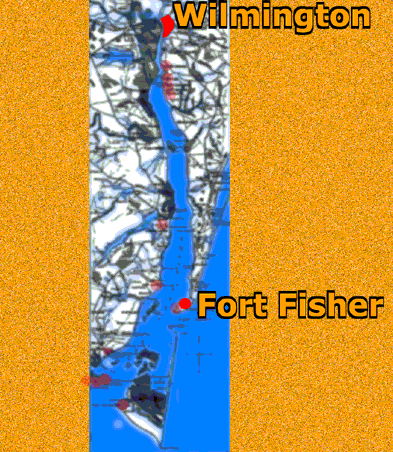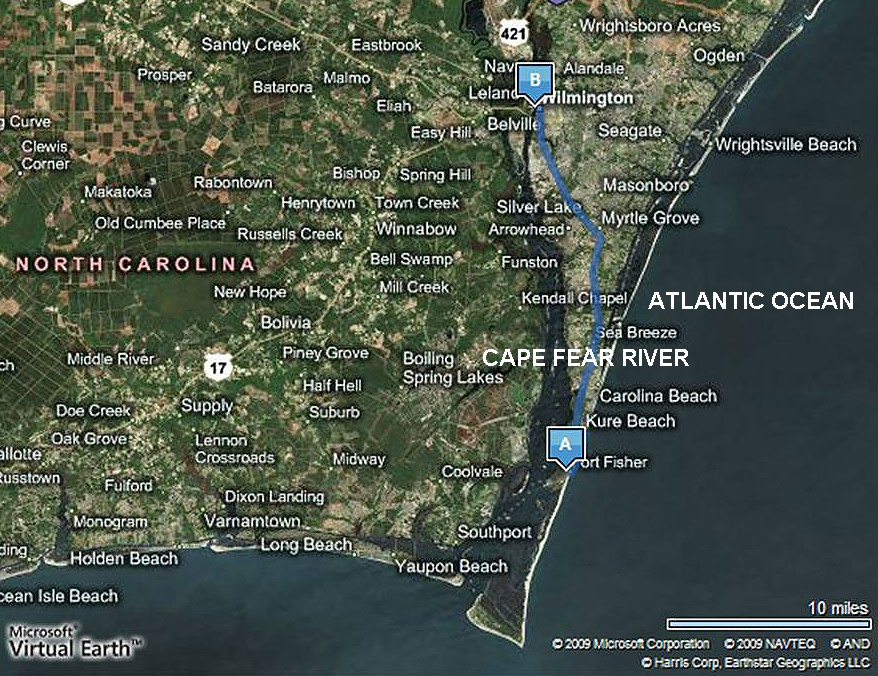|
THE MOST IMPORTANT CIVIL WAR FORT
| Cape Fear Map |

|
| Cape Fear River Defenses Map |
THE MOST IMPORTANT CIVIL WAR FORT
During the Civil War, Wilmington harbor was one of the most
significant importation depots for the South, and, consequently, mines and underwater explosives protected it. In addition,
the heavily armed Fort Fisher guarded the entrance to the harbor. Until the last few months of the Civil War, Fort Fisher
kept the port of Wilmington open to blockade-runners supplying necessary goods to Confederate armies inland (see The Blockade of Wilmington, North Carolina).
Unlike older fortifications built of brick and mortar, Fort
Fisher was made mostly of earth and sand, which was ideal for absorbing the shock of heavy explosives. By 1865, the supply
line through Wilmington was the last remaining route open to Gen. Robert E. Lee's Army of Northern Virginia.
The Union army
and navy planned several attacks on Fort Fisher and Wilmington, but made no attempt until Dec. 24, 1864. After two days of
fighting and little headway, Union commanders concluded the fort was too strong and withdrew. However, they returned for a
second attempt on Jan. 12, 1865, and for more than two days federal ships bombarded it from land and sea. Three days later,
more than 3,300 Union infantry, including the 27th U.S. Colored Troops, attacked. After several hours of fierce combat, Union
troops captured the fort. The Confederate army evacuated their remaining forts
in the Cape Fear area and within weeks Union forces overran Wilmington. Once Wilmington fell, the Confederacy’s supply
line, including the vital Wilmington and Weldon Railroad, was severed and the Civil War was soon over.
| Fort Fisher (A) to Wilmington (B) Route Map |

|
| Two strategic North Carolina Civil War battles |
Recommended Reading: Gray Phantoms of the Cape Fear
: Running the Civil War Blockade. Description: After the elimination of Charleston
in 1863 as a viable entry port for running the blockade, Wilmington, North Carolina, became the major source of external supply for the Confederacy during the
Civil War. The story of blockade running on the Cape Fear River was one of the most important
factors determining the fate of the South. With detailed and thought-provoking research, author Dawson Carr takes a comprehensive
look at the men, their ships, their cargoes, and their voyages. Continued below…
In mid-1863, the small city of
Wilmington,
North Carolina, literally found itself facing a difficult
task: it had to supply Robert E. Lee's army if the South was to continue the Civil War. Guns, ammunition, clothing, and food
had to be brought into the Confederacy from Europe, and Wilmington
was the last open port. Knowing this, the Union amassed a formidable blockading force off storied Cape Fear. What followed was a contest unique
in the annals of warfare. The blockade runners went unarmed, lest their crews be tried as pirates if captured. Neither did
the Union fleet wish to sink the runners, as rich prizes were the reward for captured cargoes. The battle was thus one of
wits and stealth more than blood and glory. As the Union naval presence grew stronger, the new breed of blockade runners got
faster, quieter, lower to the water, and altogether more ghostly and their crews more daring and resourceful. Today, the remains
of nearly three dozen runners lie beneath the waters of Cape
Fear, their exact whereabouts known to only a few fishermen and boaters.
Built for a special mission at a brief moment in time, they faded into history after the war. There had never been ships like
the blockade runners, and their kind will never be seen again. Gray Phantoms of the Cape
Fear tells the story of their captains, their crews, their cargoes, their
opponents, and their many unbelievable escapes. Rare photos and maps. “This book is nothing shy of a must read.”
Recommended
Reading: Seacoast Fortifications of the United States:
An Introductory History. Reader’s
Review: In the thirty years since this book was published, one always hoped another would equal or surpass it. None has, or
perhaps ever will. It is a marvelous history of the Forts along the American Seacoast, both Atlantic and Pacific, and even
the Philippines. …Any Fort enthusiast
must read this book. The author captures so much information, so many views, so much perspective in so few pages, the book
is breathtaking. It is easily the finest book on its chosen subject, which is why it never goes out of print. “If forts
interest you, read it, period.” The photographs from the author's collection, the army's files, the National Archives,
etc., make it an invaluable edition. Continued below…
But the text,
the clear delineation of the periods of fort building since 1794 in the US, and the differentiation of the periods,
are so worth while. Ray manages to be both terse, and pithy. It is a great tribute to any author to say that. “This
is a MUST read for anyone interested in the subject, even one only interested in their own local Fort, and how it relates
to the defense plans of the United States when it was built.” “[T]here is NO better book to read on the subject.”
Recommended Reading: Masters of the Shoals:
Tales of the Cape
Fear Pilots Who Ran
the Union Blockade. Description: Lavishly
illustrated stories of daring harbor pilots who risked their lives for the Confederacy. Following the Union's blockade of the South's waterways, the survival of the Confederacy depended on a
handful of heroes-daring harbor pilots and ship captains-who would risk their lives and cargo to outrun Union ships and guns.
Their tales of high adventure and master seamanship became legendary. Masters of the Shoals brings to life these brave pilots
of Cape
Fear who saved the
South from gradual starvation. Continued below…
REVIEWS:
"A valuable and meticulous accounting of one chapter of the South's failing struggle against the Union."
-- Washington
Times 03/06/04
"An interesting picture of a little appreciated band of professionals...Well documented...an easy read." -- Civil War
News June 2004
"An interesting picture of a little appreciated band of professionals...Will be of special interest to Civil War naval
enthusiasts." -- Civil War News May 2004
"Offers an original view of a vital but little-known aspect of blockade running." -- Military Images 03/01/04
"Surveys the whole history of the hardy seamen who guided ships around the Cape Fear's
treacherous shoals." -- Wilmington
Star-News 10/26/03
"The story [McNeil] writes is as personal as a family memoir, as authoritative and enthusiastic as the best history."
-- The Advocate 11/15/03
“Outstanding depictions of seamen courage and tenacity...Heroic, stirring, and gripping stories of the men that
dared to confront the might and power of the US Navy.” – americancivilwarhistory.org
Recommended
Reading: Confederate Goliath: The Battle of Fort
Fisher. From Publishers Weekly: Late in the Civil War, Wilmington, N.C., was the sole remaining seaport supplying Lee's army at Petersburg,
Va., with rations and munitions. In this dramatic account, Gragg describes the
two-phase campaign by which Union forces captured the fort that guarded Wilmington and the subsequent occupation of the city
itself--a victory that virtually doomed the Confederacy. In the initial phase in December 1864, General Ben Butler and Admiral
David Porter directed an unsuccessful amphibious assault against Fort
Fisher that included the war's heaviest artillery bombardment. Continued
below…
The second
try in January '65 brought General Alfred Terry's 9000-man army against 1500 ill-equipped defenders, climaxing in a bloody
hand-to-hand struggle inside the bastion and an overwhelming Union victory. Although historians tend to downplay the event,
it was nevertheless as strategically decisive as the earlier fall of either Vicksburg or Atlanta. Gragg
has done a fine job in restoring this important campaign to public attention. Includes numerous photos.
Recommended
Reading: The Wilmington Campaign: Last Departing Rays of Hope.
Description: While prior books on the battle to capture Wilmington,
North Carolina, have focused solely on the epic struggles for Fort Fisher, in many respects this was just
the beginning of the campaign. In addition to complete coverage (with significant new information) of both battles for Fort Fisher, "The Wilmington Campaign" includes the first
detailed examination of the attack and defense of Fort Anderson. It also features blow-by-blow accounts of the defense of the Sugar Loaf Line
and of the operations of Federal warships on the Cape Fear River. This masterpiece of military
history proves yet again that there is still much to be learned about the American Civil War. Continued below…
"The Wilmington
Campaign is a splendid achievement. This gripping chronicle of the five-weeks' campaign up the Cape Fear River adds a crucial dimension
to our understanding of the Confederacy's collapse." -James McPherson, Pulitzer Prize-winning author of Battle Cry of Freedom
Recommended Reading: Hurricane of Fire: The Union Assault on Fort Fisher
(Hardcover). Review: In December 1864 and January 1865, Federal forces launched the greatest amphibious assault the world
had yet seen on the Confederate stronghold of Fort Fisher,
near Wilmington, North Carolina.
This was the last seaport available to the South--all of the others had been effectively shut down by the Union's
tight naval blockade. The initial attack was a disaster; Fort
Fisher, built mainly out of beach sand, appeared almost impregnable against
a heavy naval bombardment. When troops finally landed, they were quickly repelled. A second attempt succeeded and arguably
helped deliver one of the death blows to a quickly fading Confederacy. Continued below...
Hurricane of Fire is a work of original scholarship, ably complementing Rod Gragg's Confederate Goliath,
and the first book to take a full account of the navy's important supporting role in the assault.
Recommended
Reading: Rebel Gibraltar: Fort Fisher and Wilmington, C.S.A. Description: Even before the rest of North Carolina joined her sister states in secession,
the people of the Lower Cape Fear were filled with enthusiasm for the Southern Cause - so much so that they actually seized
Forts Johnston and Caswell, at the mouth of the Cape Fear River, weeks before the first shots were fired at Fort Sumter. When
the state finally did secede, Wilmington became the most important port city of the Confederacy, keeping Robert E. Lee
supplied with the munitions and supplies he needed to fight the war against the North. Continued below…
Dedicated
soldiers like William Lamb and W.H.C. Whiting turned the sandy beaches of southern New Hanover and Brunswick Counties into
a series of fortresses that kept the Union navy at bay for four years. The mighty Fort
Fisher and a series of smaller forts offered safe haven for daring blockade
runners that brought in the Confederacy's much-needed supplies. In the process, they turned the quiet port of Wilmington into a boomtown. In this
book that was fifteen years in the making, James L. Walker, Jr. has chronicled the story of the Lower Cape Fear and the forts
and men that guarded it during America's bloodiest conflict, from the early
days of the war to the fall of Wilmington in February 1865.
Recommended
Reading: The Wilmington Campaign and the Battle for Fort Fisher, by Mark A. Moore. Description:
Full campaign and battle history of the largest combined operation in U.S.
military history prior to World War II. By late 1864, Wilmington
was the last major Confederate blockade-running seaport open to the outside world. The final battle for the port city's protector--Fort Fisher--culminated
in the largest naval bombardment of the American Civil War, and one of the worst hand-to-hand engagements in four years of
bloody fighting. Continued below…
Copious illustrations,
including 54 original maps drawn by the author. Fresh new analysis on the fall of Fort Fisher, with a fascinating comparison
to Russian defenses at Sebastopol during the Crimean War. “A tour de force. Moore's Fort Fisher-Wilmington Campaign is the best publication of this
character that I have seen in more than 50 years.” -- Edwin C. Bearss, Chief Historian Emeritus, National Park Service
|

